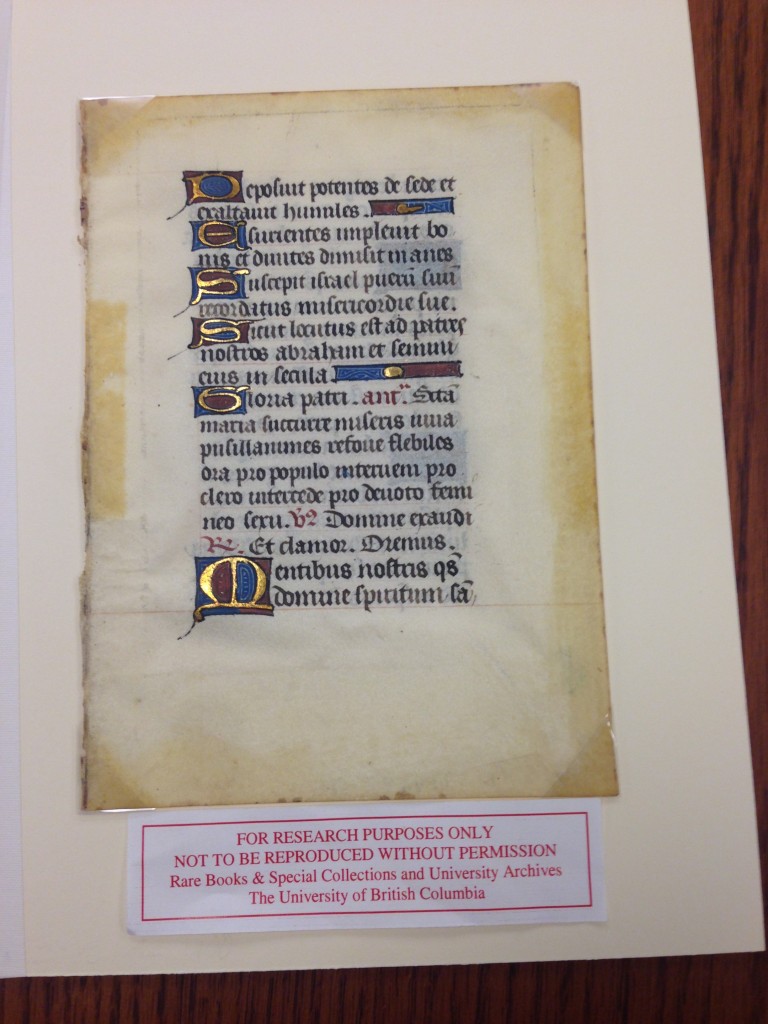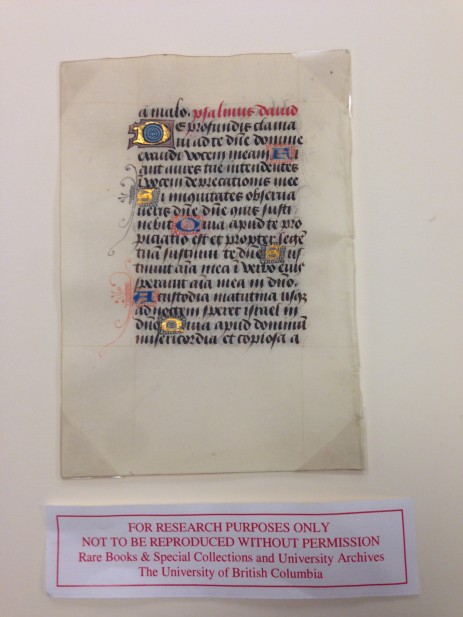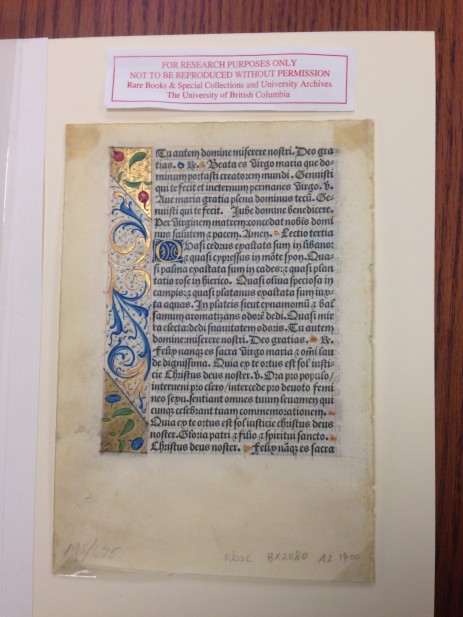I felt that a great way to start my research for this course would be to go to RBSC on my own and spend some time looking at manuscripts. Upon searching for the keywords “book of hours” and sorting the results by date on the RBSC website, I’ve encountered two items which interested me: one was their newly acquired exemplar of the book of hours, and the other was loose leaf fragments of different books of hours dated between 1400-1600 (link to this item can be viewed HERE). After examining these fragments for a couple of hours, I have observed the following (images can be expanded by clicking on them):
Plate 1:
Measurements in cm:
Page: 16.0×11.4
Margins: 1.8 (top), 2.4 (left), 3.0 (right), 4.1 (bottom).
Text: 10.1×6.0
Initials: 0.7×1.25 (top ones), 1.25×1.60 (bottom).
Lines: 0.5×6.0
Origin (or maybe just Provenance): Flanders
Script: Batard
Language: Latin
Material: Unknown (possibly parchment)
Date: 15th c.
The fragment presents texts in Latin written in black and red ink, with ornamented initials and rectangular decorations made in red, blue, and gold. Both the initials and the decorations are lined with black ink, which implies that perhaps the scribe was possibly the one who has decorated the text. Marks above certain letters, such as the “qs~” on line 17 and “sa~” on line 18, indicate abbreviations in the text. The manuscript is lined with a faint red ink on the left, top, and bottom, but not on the right. Text hovers over the lines, with only descenders crossing them.
I have provided a transcript for the text below and a tentative translation (since I’m still learning about paleography and do not know Latin, both might be imperfect; nonetheless, I’ve enjoyed transcribing and attempting to translate this excerpt):
Notes about transcriptions and translations:
- Decorated initials are bolded.
- Abbreviations have been either expanded or signed with a ^ symbol.
- Red text is underlined.
- Decorations are marked by /~~~~/.
- Missing/Unknown translations are marked with _____.
Transcription:
[…]
Depofuit potentes de sede et
Exaltauit humiles. /~~~~~~/
Esurientes impleuit bo
nis et diuites dimisit manes
Suscepit israel pueru siui
Recordatus misericordie sue.
Sicut locutus est ad patres
nostros abraham et semuu
euis in secula. /~~~~~~~~/
Gloria patri. Anf^. Santa
maria succurre miseris uiua
pusillanimes refove flebiles
ora pro populo interuem pro
clero intercede pro deuoto femi
neo sexu. b^2 Domine exaudi
Rx. Et clamor. Oremus.
Mentibus nostris qs^
domine spiritum san
[…]
Translation:
[…]
Have committed the mighty from their thrones, and
Lifted up the lowly. /~~~~~~/
The hungry with good
end and let the rich shades
He has helped his own
He remembered his mercy.
As he spoke to our fathers
To Abraham and Semur
gratitude for all ages. /~~~~~~~~/
Glory. _____. Saint
Mary, succor the poor living
revive the feeble-minded
Pray for the people, plead for
the clergy, intercede for all devout women
consecrated to God. _____ Lord hear
____ my cry. Let us pray.
Our minds ______
O Holy Spirit
[…]
I’m unfamiliar with the name “Semur,” but after searching the terms “Semur Bible” on google, I have encountered a result including the expression “The passion of Semur.” I haven’t managed to learn more about it though and will need to research further. A closer reading of this passage is also pending.
Plate 2:
Measurements in cm:
Page: 12.1×8.45
Margins: 1.43 (top), 2.1 (left), 1.48 (right), 3.6 (bottom).
Text: 7.07×4.87
Initials: 0.8×1.25 (top one), 0.85×1.25 (others).
Lines: 0.4×4.87
Origin (or maybe just Provenance): Paris
Script: Pending
Language: Latin
Material: Vellum
Date: 1510
Text is written in black and red ink, with decorated initials in blue, gold, and red. Text contains several abbreviations (some of which I was unable to decode). I will need more time or perhaps some help to translate this passage. I can see that it refers to the psalm of David because of the first line in red, but need further training to understand the rest. Initials close to the left margin contain ornamented flourishes in black and red, which seem to be more elaborate than the other initials in this excerpt.The manuscript is lined with faint black ink, which borders all margins, containing the text in a box.
(Attempted) Transcription:
[…]
a malo. psalmus dauid
Ds profundis clama
Iuadte dii^e domine
exxuidi vocem meam Ar
ant auire tue intendentes
i^ vocem demerationis mee
Si mi9uitates obserua
ueris dii^e dii^e quis susti
nebit Quia apud te pro
piaatio est et propter lege^
tua sustimu te dii^e Sus
timut ai^a mea in dii^o,
A custodia matutina usi^
ad noctem sperer Israel in
dii^o Quia apud dominus
misericordia et copiosa a
[…]
Plate 3:
Measurements in cm:
Page: 18.0×12.5
Margins: 0.9 (top), 1.85 (left), 1.45 (right), 4.5 (bottom).
Text: 12.35×9.2
Border: 12.35×1.77
Initial: 1.25×0.9
Lines: 0.45×7.4
Origin (or maybe just Provenance): Unknown
Script: Pending
Language: Latin
Material: Unknown
Date: 1400-1600 (exact date unknown)
Manuscript contains an annotation at the bottom, identifying it as “MS/475.” I haven’t had the chance to research more about this specific MS, but will try to learn more about it soon. Main text in written in black ink, with blue, red, and gold markers separating certain sentences and one decorated initial in blue and gold. It also contains a very elaborate decorated border composed of floral patterns made with red, green, blue, and gold ink. The text is lined with faint red ink, which borders all margins, containing the main text in a text box. The text hovers over the lines, having only ascenders and descenders touching them.
Out of all of the fragments, this one was the easiest to transcribe and translate (perhaps due to this specific script). It was a very interesting experience which made me instinctively learn a little bit about Latin syntax.
Transcription:
[…]
Tu autem domine miserere nostri. Deo gra
tias. * Bx. * Beata es virgo maria que do=
minum portasti creatorem mundi. Genuisti
qui te fecit et ineternum permanes virgo. b^.
Aue maria gratia plena dominus tecu^. Ge=
nuisti qui te fecit. Iube domine benedicere.
Per virginem matrem: concedat nobis domi
nus salute et pacem. Amen. * Lectio tertia
Quasi cedrus exaltata sum in libano:
et quasi cypressus in mo^te syon. Qua=
si palma exaltata sum in cades: et quasi plan
tatio rose in hierico. Quasi oliua speciosa in
campis: et quasi platanus exaltata sum iux=
ta aquas. In plateis sicut cynamomun et bal
samum aromatizans odore dedi. Quasi mir
ra electa : dedi suauitatem odoris. Tu autem
domine: miserere nostri. Deo gratias. * Bx.
felix nanque es sacra virgo maria et omi lau
de dignissima. Quia ex te ortus est sol iusti=
cie Christus deus noster. b^. Ora pro populo/
interueni pro clero/ intercede pro deuoto femi
neo sexu. sentiant omnes tuum leuamen qui
cunque celebrant tuam commemorationem. *
Quia ex te ortus est sol iusticie christus deus
noster. Gloria patri et filio et spiritui sancto.*
Christus deus noster. * Felix nanque es sacra
[…]
Translation:
[…]
But you, O Lord, have mercy on us. God’s
grace. * Bx. Blessed art thou, * O Virgin Mary, who
didst bear the Lord, the Creator of the world. Hast borne
Him Who made thee: and eternally remain a virgin. b.
Hail, Mary, full of grace The Lord is with thee. Who
gave birth to yourself. May the Lord bless.
Through the Virgin Mother, the Lord grant us
salvation and peace. Amen. * The third lesson
I was exalted like a cedar in the Lebanon:
and as a cypress tree on mount Sion. I was
exalted like a palm tree in Cades, and as
a rose in Jericho. As an olive tree in
the plains: and as a plane tree growing beside
the water. I gave a sweet smell like cinnamon and balsam
and in the streets. As a chosen myrrh:
I have given the pleasantness of odor. But thou,
O Lord, have mercy on us. We thank thee. * Bx.
For you are the holy Virgin Mary, happy, and
worthy of all praise. For out of thee hath risen
the sun of justice, Christ our God. Pray for the people/
plead for the clergy/ intercede for all devout women
consecrated to God. let all feel thy burden from those
who celebrate your memory. *
For out of thee hath risen the sun of justice, Christ
our God. Glory to the Father and to the Son and to the Holy Ghost. *
Christ, our God.* Happy art thou, sacred
[…]
After examining these fragments, I had a nice chat with Chelsea and Sue (whom I had the chance to meet for the first time) while we tried to figure out the provenance of each manuscript.
Sue recommended the following book for figuring out scripts:
Brown, Michelle P. A Guide to Historical Scripts from Antiquity to 1600. -> LINK
I’ll take a look at it next week as I add more info to this blog.
And just to finish this post with a quote that always makes me laugh:
“It is full merry in heaven!”
-The Book of Margery Kempe



